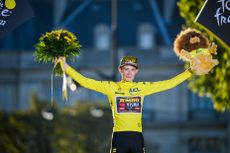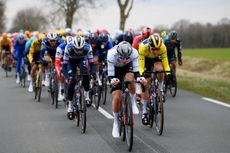Strade Bianche 2023: all you need to know about the route
All the key route info on the Tuscan classic
- (opens in new tab)
- (opens in new tab)
- (opens in new tab)
- Sign up to our newsletter Newsletter
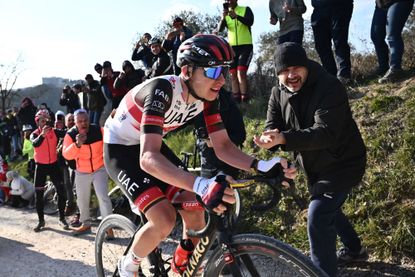

Strade Bianche 2023 route (men's)
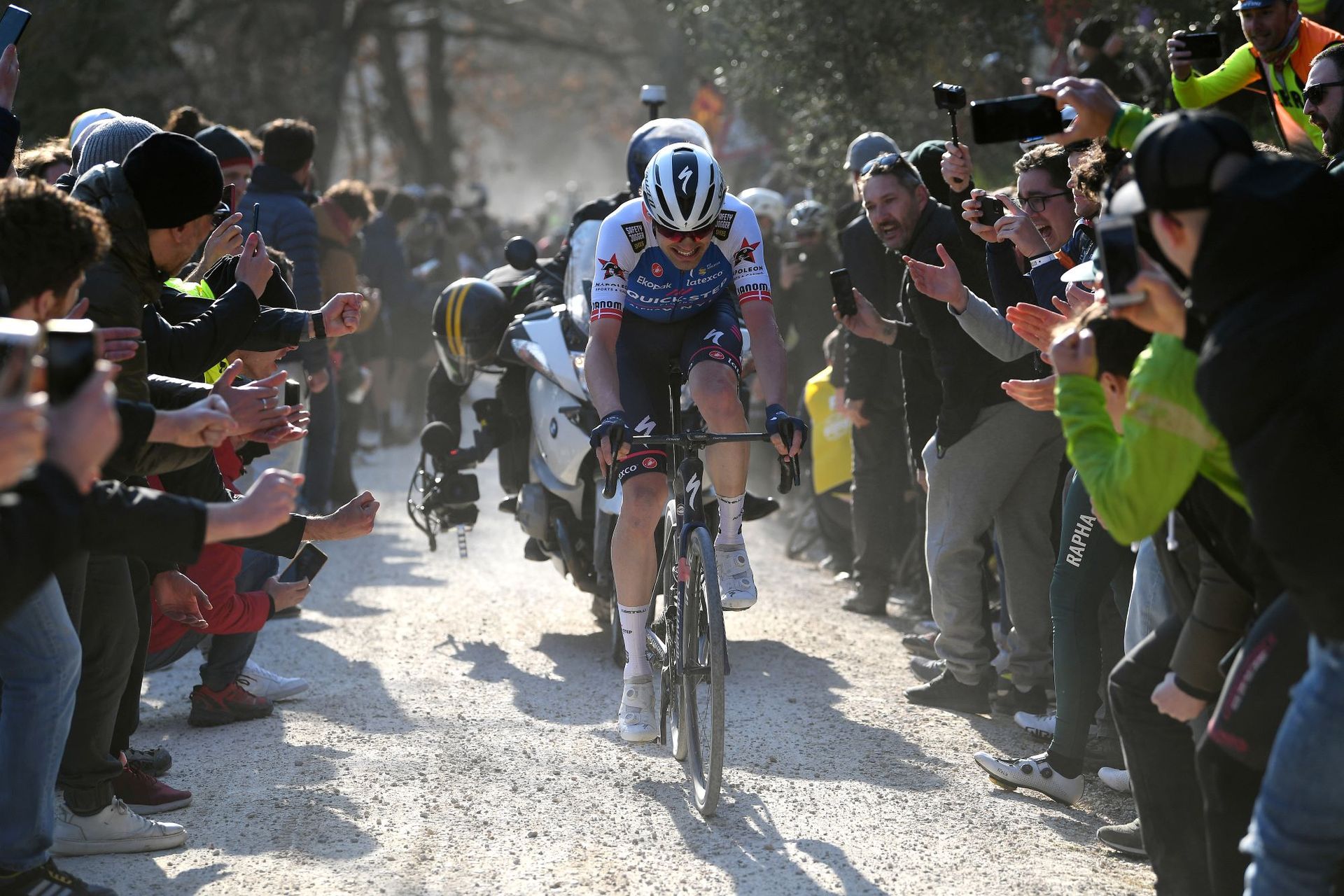
The route for the men’s edition of the 17th edition of Strade Bianche is unchanged from last year’s race, taking place over 184 kilometres, departing from the Fortezza Medicea in Siena before wrapping up later in the day with the gruelling climb up the Via Santa Caterina to the iconic Piazza del Campo square in the city’s historic centre.
Strade Bianche has rapidly become a favourite of cycling fans as well as riders worldwide, and in the past there has even been calls for the men’s event to become the sixth cycling monument due to its iconic parcours across the sterrato or white gravel roads across the Tuscany region.
Speaking of gravel, there are 11 sectors on the course for the men which make up more than 63 kilometres of the total route. Each of the sectors are given a scale of one to five stars, one being the easiest and five the toughest.
The longest of the sectors is 11.9 kilometres, and it was on that particular sector where we saw a large crash last year which took out multiple riders including Julian Alaphilippe.
Wout van Aert, a previous winner of the race, won't feature this year on the start list due to illness.
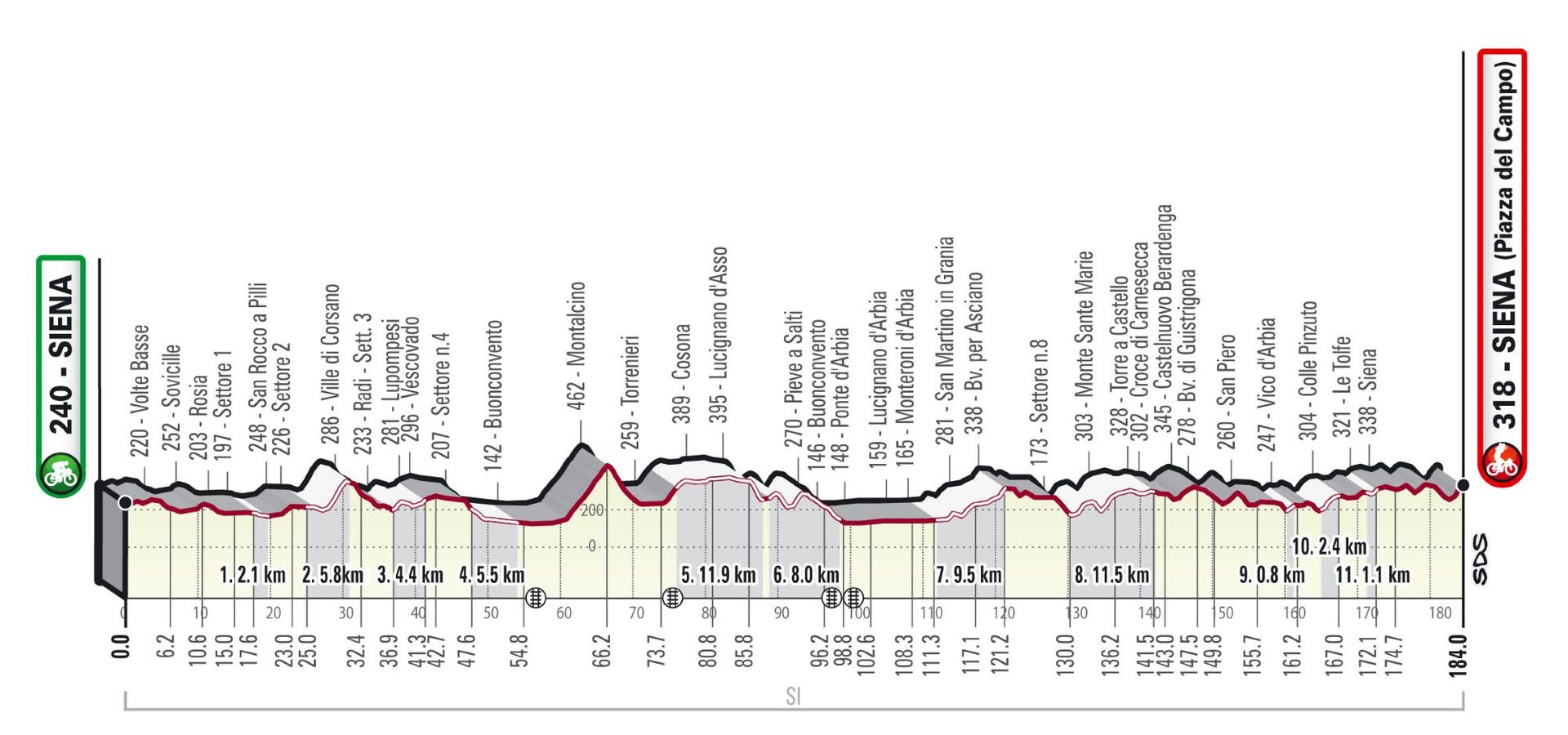
The gravel starts fairly early on, and after just 18 kilometres of undulating terrain the riders will reach sector one. At only 2.1 kilometres in length, it makes for a gentle introduction to the gravel, particularly as it’s mainly downhill before a particularly nasty 10% gradient uphill section which comes just moments later.
After the riders have tackled section three, they’ll reach La Piana, the fourth and ever-present sector, before they then reach the second gravel climb of the day, Montalcino, a nasty four kilometre long climb which bites at 5%. Montalcino comes just before the longest 11.9 kilometre sector, which is then swiftly followed by sector six, a punchy eight kilometres in length.
Shortly after the feed zone, it’s likely that the race will be beginning to hot up. Monteroni d’Arbia is next up which marks the start of sector seven. The 9.5 kilometre section is relatively up and down, ending with a twisting, punchy climb up to tarmac roads once more.

The final climb of the Via Santa Caterina has rapidly become one of cycling's most famous finishes
A brief descent on the road brings the riders to the foot of the Monte Sante Marie climb, which marks the start of section eight. According to the organisers, it's arguably the toughest.
The next section is relatively short, but by no means easy. Sector nine is just 800 metres long, but it is solely a short and sharp climb back onto tarmac once more before the riders reach the penultimate sector of the day.
Strade di Colle Pinzuto is absolutely brutal, featuring ramps of more than 15% gradient, and it keeps twisting and turning uphill around several hairpin bends to the end. Sector 11 is relatively flat before the riders then take on the hilly roads into Siena towards the Piazza del Campo.
The final kilometre of the day's action is now very much seen as being one of cycling’s most iconic climbs. At 16% gradient on huge stone slabs, the Via Santa Caterina makes for an unbelievably brutal end to a bike race before the flat finish in the beautiful Piazza del Campo.
Strade Bianche 2023 route (women's)

A large proportion of the gravel sections on the men’s route also feature on the women’s, even though the Strade Bianche Donne route is shorter at 136 kilometres in length. Beginning in Siena, the women’s peloton will roll out of the city for 18 kilometres before they encounter the first section of gravel. The same 2.1 kilometre section as the men.
Ville di Corsano is the first real test of the day, featuring a 5.8 kilometre gravel climb before the route then takes the peloton through to Radi, and onto section three and four of the gravel. At that point, the riders then return to tarmacked roads which should make for a smooth passage through to Monteroni d’Arbia where the fifth gravel sector will begin.
At 9.5 kilometres in length, it should provide a stern test for even the most accomplished of bike handlers in the Crete Senesi, with a nasty short ramp at the end back up onto the tarmac once more.
A large gap of 40 kilometres on the tarmac separates sectors five and six on the gravel. Sector six is a nasty 800 metre ramp with gradients well into double figures up to Vico d’Arbia.
Next up is the Colle Pinzuto sector, a formidable opponent for tired legs with its 15% gradient ramps and slippery surfaces. The final sector nine is short at just over a single kilometre in length featuring demanding descents and climbs towards the final kilometre in the heart of Siena.
The finale is the same as the men’s, the steep and famous climb to the Pizza del Campo up the Via Santa Caterina.
How to watch
Find out how you can tune into all the action, no matter where you are in the world, on our how to watch Strade Bianche guide.

Thank you for reading 10 articles this month* Join now for unlimited access
Enjoy your first month for just £1 / $1 / €1
*Read 5 free articles per month without a subscription

Join now for unlimited access
Try first month for just £1 / $1 / €1

Tom is a News and Features Writer at Cycling Weekly, and previously worked in communications at Oxford Brookes University. Alongside his day job, prior to starting with the team, he wrote a variety of different pieces as a contributor to a cycling website, Casquettes and Bidons, including interviews with up and coming British riders.
Back in the day, Tom spent many summers visiting family in the South of France, catching the Tour de France from the roadside wherever possible. His favourite races are Strade Bianche and the Tour, and he hopes to ride the white gravel roads himself in the years to come.
Away from cycling, Tom’s interests include following football and researching First World War history.
-
-
 Summit finish and final day time-trial for 2024 Tour de France finale in Nice
Summit finish and final day time-trial for 2024 Tour de France finale in NiceStage 20 will finish atop the Col de la Couillole before final day race against the clock in Nice
By Tom Thewlis • Published
-
 Closing the gap: David Gaudu emerges from Paris-Nice more confident than ever before
Closing the gap: David Gaudu emerges from Paris-Nice more confident than ever beforeThe Groupama-FDJ rider finished second overall at the Race to the Sun, but gained more than just the result
By Adam Becket • Published
-
 Paris-Nice just first step on the road to Tour de France redemption for Tadej Pogačar
Paris-Nice just first step on the road to Tour de France redemption for Tadej PogačarThe UAE Team Emirates rider might have won the Race to the Sun but he is not taking anything for granted
By Adam Becket • Published
-
 Tadej Pogačar wraps up 'dream' victory at Paris-Nice with solo stage win
Tadej Pogačar wraps up 'dream' victory at Paris-Nice with solo stage winSlovenian finishes 53 seconds clear of David Gaudu, with Jonas Vingegaard third and Simon Yates fourth
By Peter Cossins • Published
-
 Big two becomes big three as Gaudu joins Pogačar and Vingegaard at Paris-Nice
Big two becomes big three as Gaudu joins Pogačar and Vingegaard at Paris-NiceTadej Pogačar might have won again, but it was close, and David Gaudu could yet win Paris-Nice
By Adam Becket • Published
-
 'He cracked a little bit': First blow to Tadej Pogačar at Paris-Nice as Jonas Vingegaard fades
'He cracked a little bit': First blow to Tadej Pogačar at Paris-Nice as Jonas Vingegaard fadesUAE Team Emirates rider is back in yellow on French soil for the first time since stage 11 of last year's Tour de France
By Adam Becket • Published
-
 Tadej Pogačar takes Paris-Nice lead with dominant mountaintop victory on stage four
Tadej Pogačar takes Paris-Nice lead with dominant mountaintop victory on stage fourThe Slovenian will wear the yellow leader's jersey on stage five
By Tom Davidson • Published
-
 Tom Boonen invited to test Colnago V4Rs after criticism of Tadej Pogačar's bike
Tom Boonen invited to test Colnago V4Rs after criticism of Tadej Pogačar's bikeBoonen and fellow ex-pro Dirk de Wolf invited to Italy for a "public conversation" on the data they used to make claim that bike hindered two-time Tour de France champion
By Tom Thewlis • Published
-
 Fear or insurance: Why does Tadej Pogačar keep sprinting for bonus seconds at Paris-Nice?
Fear or insurance: Why does Tadej Pogačar keep sprinting for bonus seconds at Paris-Nice?UAE Team Emirates' Slovenian maestro has 12 seconds on his GC competitors already thanks to bonus sprints
By Adam Becket • Published
-
 Opinion: Alpe d’Huez was masterful, but Strade Bianche win was Tom Pidcock’s finest yet
Opinion: Alpe d’Huez was masterful, but Strade Bianche win was Tom Pidcock’s finest yetThe stunning victory forged in the dust of Monte Sante Marie firmly eclipsed last summer's Tour de France stage winning glory
By Tom Thewlis • Published
